BizOps Enterprises: A Report on Continuous Process Improvement Plan
VerifiedAdded on 2023/06/10
|7
|1326
|270
Report
AI Summary
This report details a Continuous Process Improvement (CPI) plan for BizOps Enterprises, a company with retail shops, online stores, and phone sale outlets in Australia that focuses on providing ‘green’ services and products. The CPI aims to improve products, services, and processes, increasing organizational efficiency to achieve strategic objectives, particularly recruiting and retaining the right people. The plan involves encouraging staff participation in decision-making and professional development, aligning with the company's goals for financial stability, market position, and employee development from 2015 to 2020. The report explains CPI principles, including feedback, efficiency, and evolution, and suggests using the kaizen approach. The CPI implementation plan follows the PDCA (Plan, Do, Check, Act) cycle and the DMAIC (Define, Measure, Analyze, Improve, Control) method to systematically implement improvements and ensure clarity, accountability, and employee involvement.
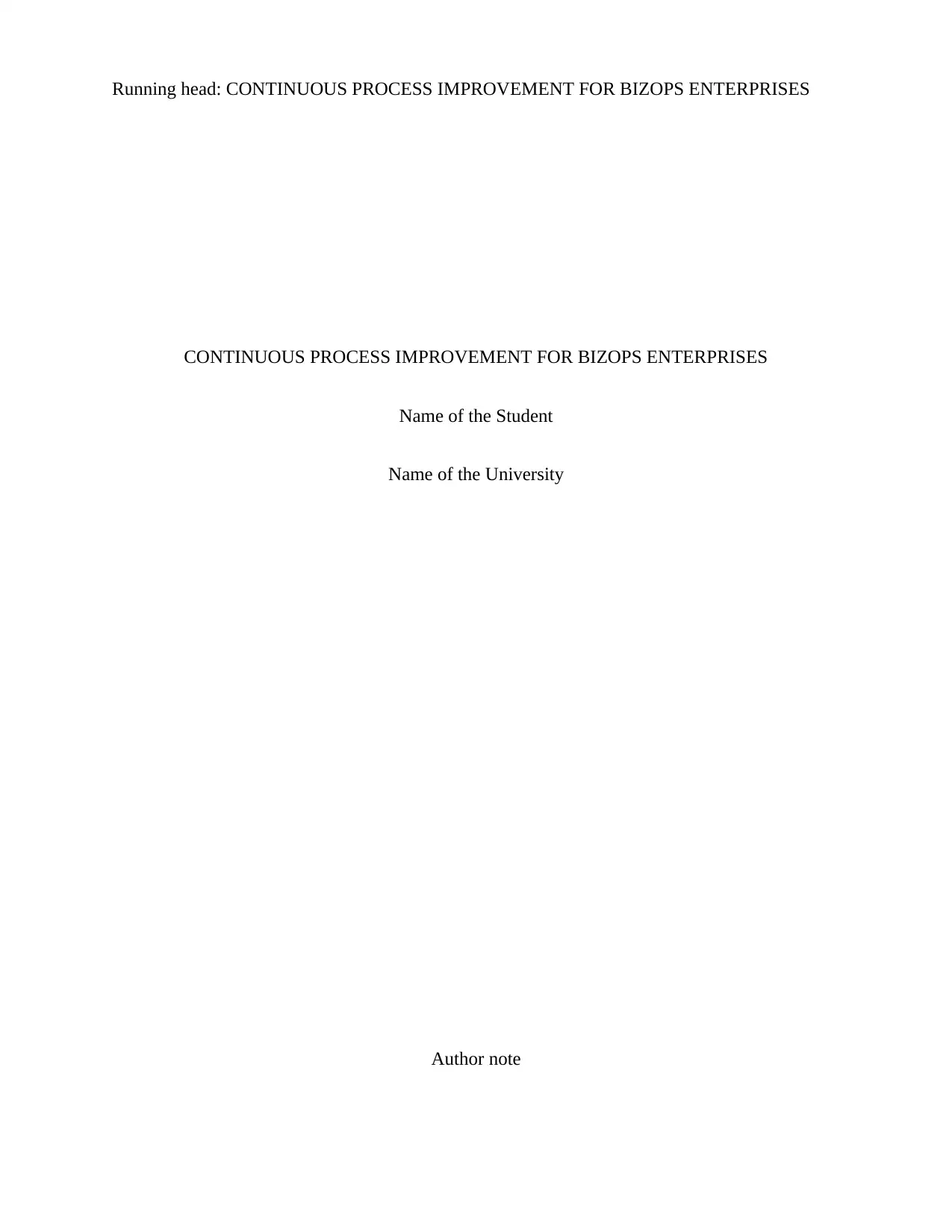
Running head: CONTINUOUS PROCESS IMPROVEMENT FOR BIZOPS ENTERPRISES
CONTINUOUS PROCESS IMPROVEMENT FOR BIZOPS ENTERPRISES
Name of the Student
Name of the University
Author note
CONTINUOUS PROCESS IMPROVEMENT FOR BIZOPS ENTERPRISES
Name of the Student
Name of the University
Author note
Paraphrase This Document
Need a fresh take? Get an instant paraphrase of this document with our AI Paraphraser
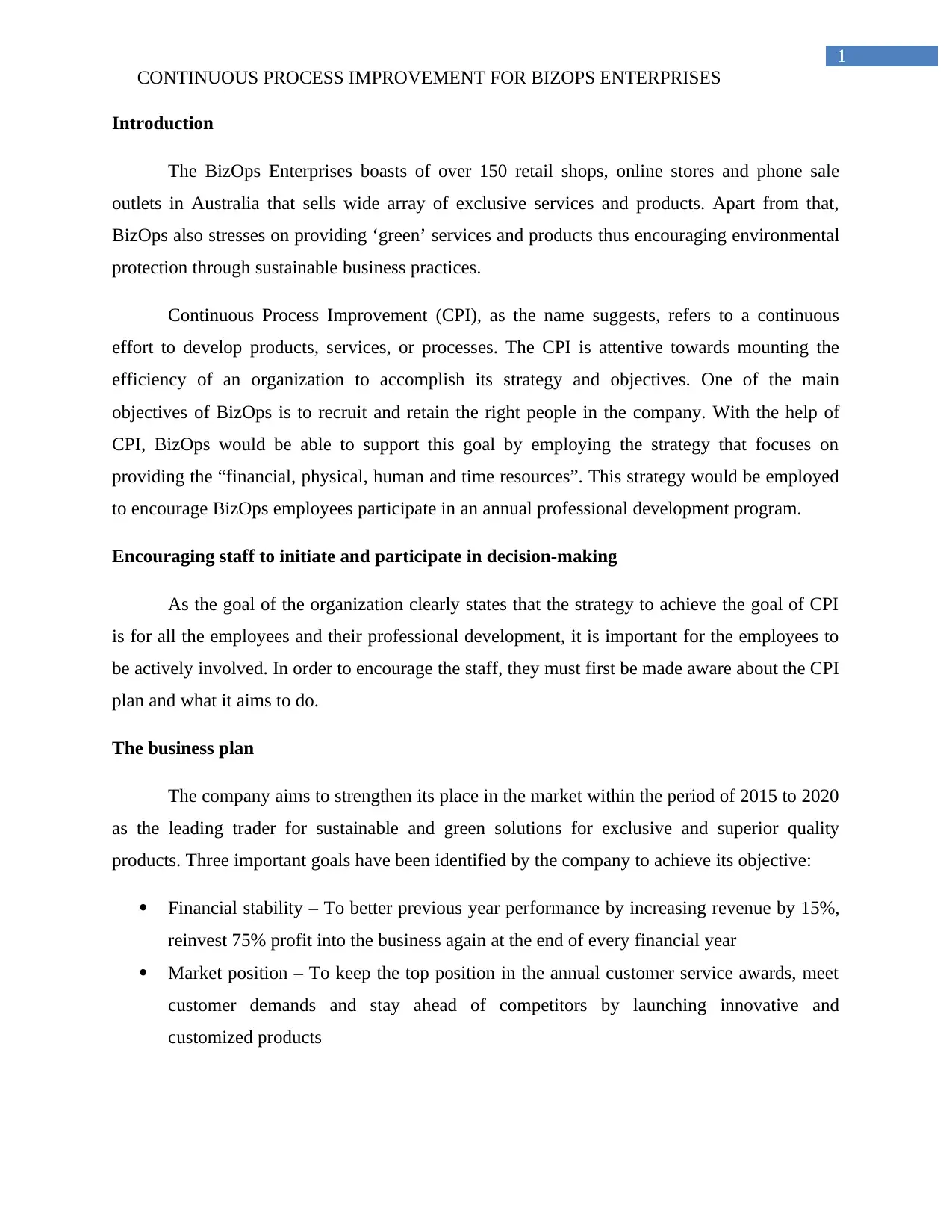
1
CONTINUOUS PROCESS IMPROVEMENT FOR BIZOPS ENTERPRISES
Introduction
The BizOps Enterprises boasts of over 150 retail shops, online stores and phone sale
outlets in Australia that sells wide array of exclusive services and products. Apart from that,
BizOps also stresses on providing ‘green’ services and products thus encouraging environmental
protection through sustainable business practices.
Continuous Process Improvement (CPI), as the name suggests, refers to a continuous
effort to develop products, services, or processes. The CPI is attentive towards mounting the
efficiency of an organization to accomplish its strategy and objectives. One of the main
objectives of BizOps is to recruit and retain the right people in the company. With the help of
CPI, BizOps would be able to support this goal by employing the strategy that focuses on
providing the “financial, physical, human and time resources”. This strategy would be employed
to encourage BizOps employees participate in an annual professional development program.
Encouraging staff to initiate and participate in decision-making
As the goal of the organization clearly states that the strategy to achieve the goal of CPI
is for all the employees and their professional development, it is important for the employees to
be actively involved. In order to encourage the staff, they must first be made aware about the CPI
plan and what it aims to do.
The business plan
The company aims to strengthen its place in the market within the period of 2015 to 2020
as the leading trader for sustainable and green solutions for exclusive and superior quality
products. Three important goals have been identified by the company to achieve its objective:
Financial stability – To better previous year performance by increasing revenue by 15%,
reinvest 75% profit into the business again at the end of every financial year
Market position – To keep the top position in the annual customer service awards, meet
customer demands and stay ahead of competitors by launching innovative and
customized products
CONTINUOUS PROCESS IMPROVEMENT FOR BIZOPS ENTERPRISES
Introduction
The BizOps Enterprises boasts of over 150 retail shops, online stores and phone sale
outlets in Australia that sells wide array of exclusive services and products. Apart from that,
BizOps also stresses on providing ‘green’ services and products thus encouraging environmental
protection through sustainable business practices.
Continuous Process Improvement (CPI), as the name suggests, refers to a continuous
effort to develop products, services, or processes. The CPI is attentive towards mounting the
efficiency of an organization to accomplish its strategy and objectives. One of the main
objectives of BizOps is to recruit and retain the right people in the company. With the help of
CPI, BizOps would be able to support this goal by employing the strategy that focuses on
providing the “financial, physical, human and time resources”. This strategy would be employed
to encourage BizOps employees participate in an annual professional development program.
Encouraging staff to initiate and participate in decision-making
As the goal of the organization clearly states that the strategy to achieve the goal of CPI
is for all the employees and their professional development, it is important for the employees to
be actively involved. In order to encourage the staff, they must first be made aware about the CPI
plan and what it aims to do.
The business plan
The company aims to strengthen its place in the market within the period of 2015 to 2020
as the leading trader for sustainable and green solutions for exclusive and superior quality
products. Three important goals have been identified by the company to achieve its objective:
Financial stability – To better previous year performance by increasing revenue by 15%,
reinvest 75% profit into the business again at the end of every financial year
Market position – To keep the top position in the annual customer service awards, meet
customer demands and stay ahead of competitors by launching innovative and
customized products
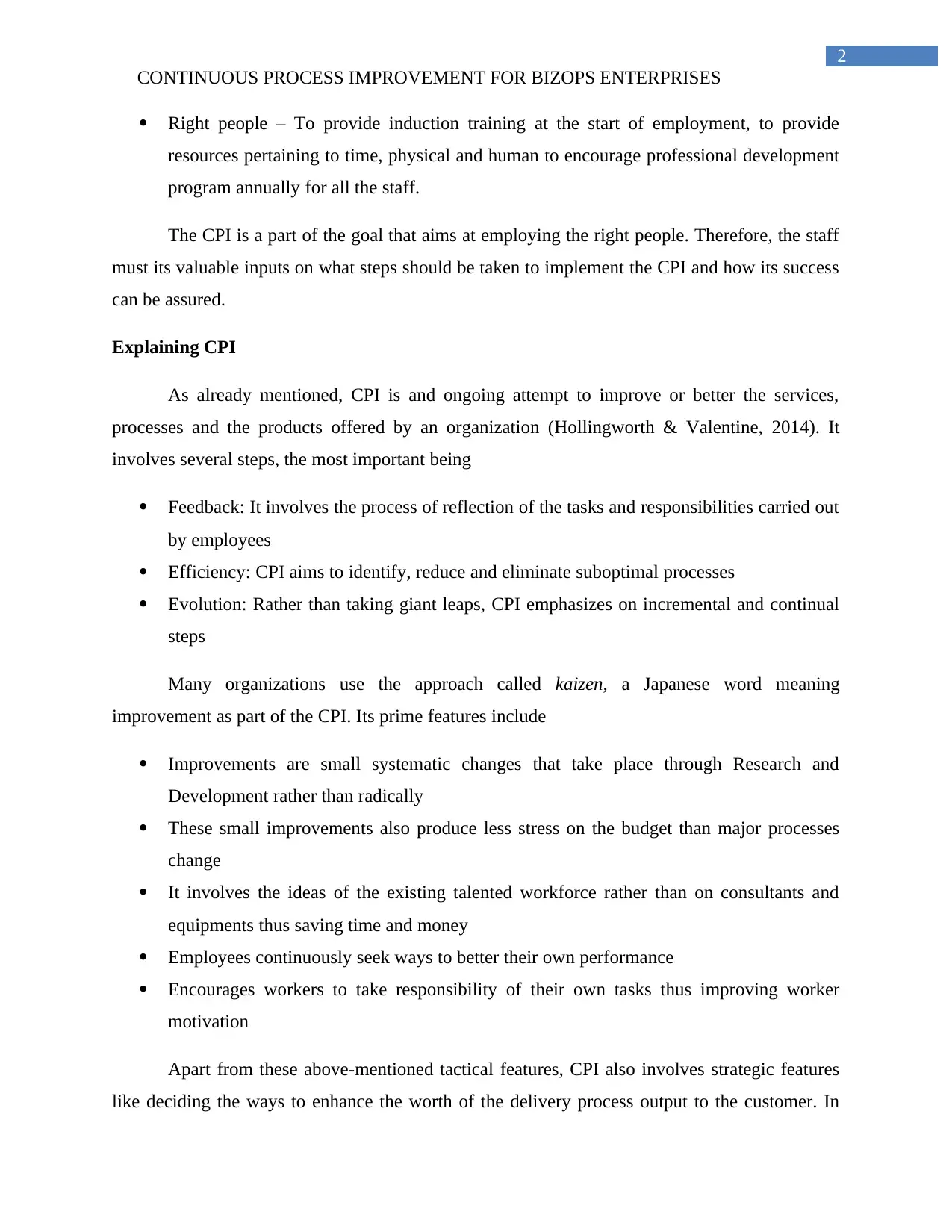
2
CONTINUOUS PROCESS IMPROVEMENT FOR BIZOPS ENTERPRISES
Right people – To provide induction training at the start of employment, to provide
resources pertaining to time, physical and human to encourage professional development
program annually for all the staff.
The CPI is a part of the goal that aims at employing the right people. Therefore, the staff
must its valuable inputs on what steps should be taken to implement the CPI and how its success
can be assured.
Explaining CPI
As already mentioned, CPI is and ongoing attempt to improve or better the services,
processes and the products offered by an organization (Hollingworth & Valentine, 2014). It
involves several steps, the most important being
Feedback: It involves the process of reflection of the tasks and responsibilities carried out
by employees
Efficiency: CPI aims to identify, reduce and eliminate suboptimal processes
Evolution: Rather than taking giant leaps, CPI emphasizes on incremental and continual
steps
Many organizations use the approach called kaizen, a Japanese word meaning
improvement as part of the CPI. Its prime features include
Improvements are small systematic changes that take place through Research and
Development rather than radically
These small improvements also produce less stress on the budget than major processes
change
It involves the ideas of the existing talented workforce rather than on consultants and
equipments thus saving time and money
Employees continuously seek ways to better their own performance
Encourages workers to take responsibility of their own tasks thus improving worker
motivation
Apart from these above-mentioned tactical features, CPI also involves strategic features
like deciding the ways to enhance the worth of the delivery process output to the customer. In
CONTINUOUS PROCESS IMPROVEMENT FOR BIZOPS ENTERPRISES
Right people – To provide induction training at the start of employment, to provide
resources pertaining to time, physical and human to encourage professional development
program annually for all the staff.
The CPI is a part of the goal that aims at employing the right people. Therefore, the staff
must its valuable inputs on what steps should be taken to implement the CPI and how its success
can be assured.
Explaining CPI
As already mentioned, CPI is and ongoing attempt to improve or better the services,
processes and the products offered by an organization (Hollingworth & Valentine, 2014). It
involves several steps, the most important being
Feedback: It involves the process of reflection of the tasks and responsibilities carried out
by employees
Efficiency: CPI aims to identify, reduce and eliminate suboptimal processes
Evolution: Rather than taking giant leaps, CPI emphasizes on incremental and continual
steps
Many organizations use the approach called kaizen, a Japanese word meaning
improvement as part of the CPI. Its prime features include
Improvements are small systematic changes that take place through Research and
Development rather than radically
These small improvements also produce less stress on the budget than major processes
change
It involves the ideas of the existing talented workforce rather than on consultants and
equipments thus saving time and money
Employees continuously seek ways to better their own performance
Encourages workers to take responsibility of their own tasks thus improving worker
motivation
Apart from these above-mentioned tactical features, CPI also involves strategic features
like deciding the ways to enhance the worth of the delivery process output to the customer. In
⊘ This is a preview!⊘
Do you want full access?
Subscribe today to unlock all pages.

Trusted by 1+ million students worldwide
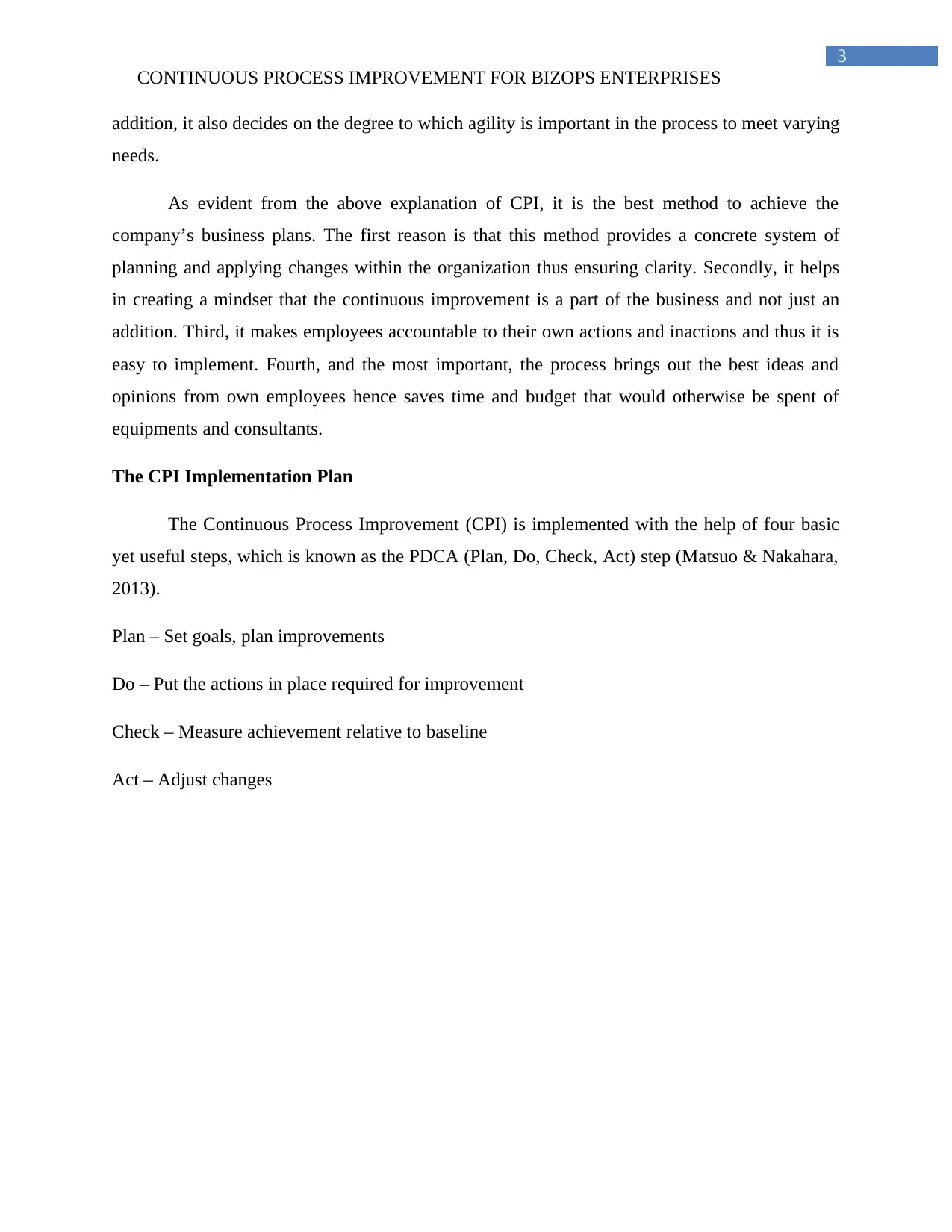
3
CONTINUOUS PROCESS IMPROVEMENT FOR BIZOPS ENTERPRISES
addition, it also decides on the degree to which agility is important in the process to meet varying
needs.
As evident from the above explanation of CPI, it is the best method to achieve the
company’s business plans. The first reason is that this method provides a concrete system of
planning and applying changes within the organization thus ensuring clarity. Secondly, it helps
in creating a mindset that the continuous improvement is a part of the business and not just an
addition. Third, it makes employees accountable to their own actions and inactions and thus it is
easy to implement. Fourth, and the most important, the process brings out the best ideas and
opinions from own employees hence saves time and budget that would otherwise be spent of
equipments and consultants.
The CPI Implementation Plan
The Continuous Process Improvement (CPI) is implemented with the help of four basic
yet useful steps, which is known as the PDCA (Plan, Do, Check, Act) step (Matsuo & Nakahara,
2013).
Plan – Set goals, plan improvements
Do – Put the actions in place required for improvement
Check – Measure achievement relative to baseline
Act – Adjust changes
CONTINUOUS PROCESS IMPROVEMENT FOR BIZOPS ENTERPRISES
addition, it also decides on the degree to which agility is important in the process to meet varying
needs.
As evident from the above explanation of CPI, it is the best method to achieve the
company’s business plans. The first reason is that this method provides a concrete system of
planning and applying changes within the organization thus ensuring clarity. Secondly, it helps
in creating a mindset that the continuous improvement is a part of the business and not just an
addition. Third, it makes employees accountable to their own actions and inactions and thus it is
easy to implement. Fourth, and the most important, the process brings out the best ideas and
opinions from own employees hence saves time and budget that would otherwise be spent of
equipments and consultants.
The CPI Implementation Plan
The Continuous Process Improvement (CPI) is implemented with the help of four basic
yet useful steps, which is known as the PDCA (Plan, Do, Check, Act) step (Matsuo & Nakahara,
2013).
Plan – Set goals, plan improvements
Do – Put the actions in place required for improvement
Check – Measure achievement relative to baseline
Act – Adjust changes
Paraphrase This Document
Need a fresh take? Get an instant paraphrase of this document with our AI Paraphraser
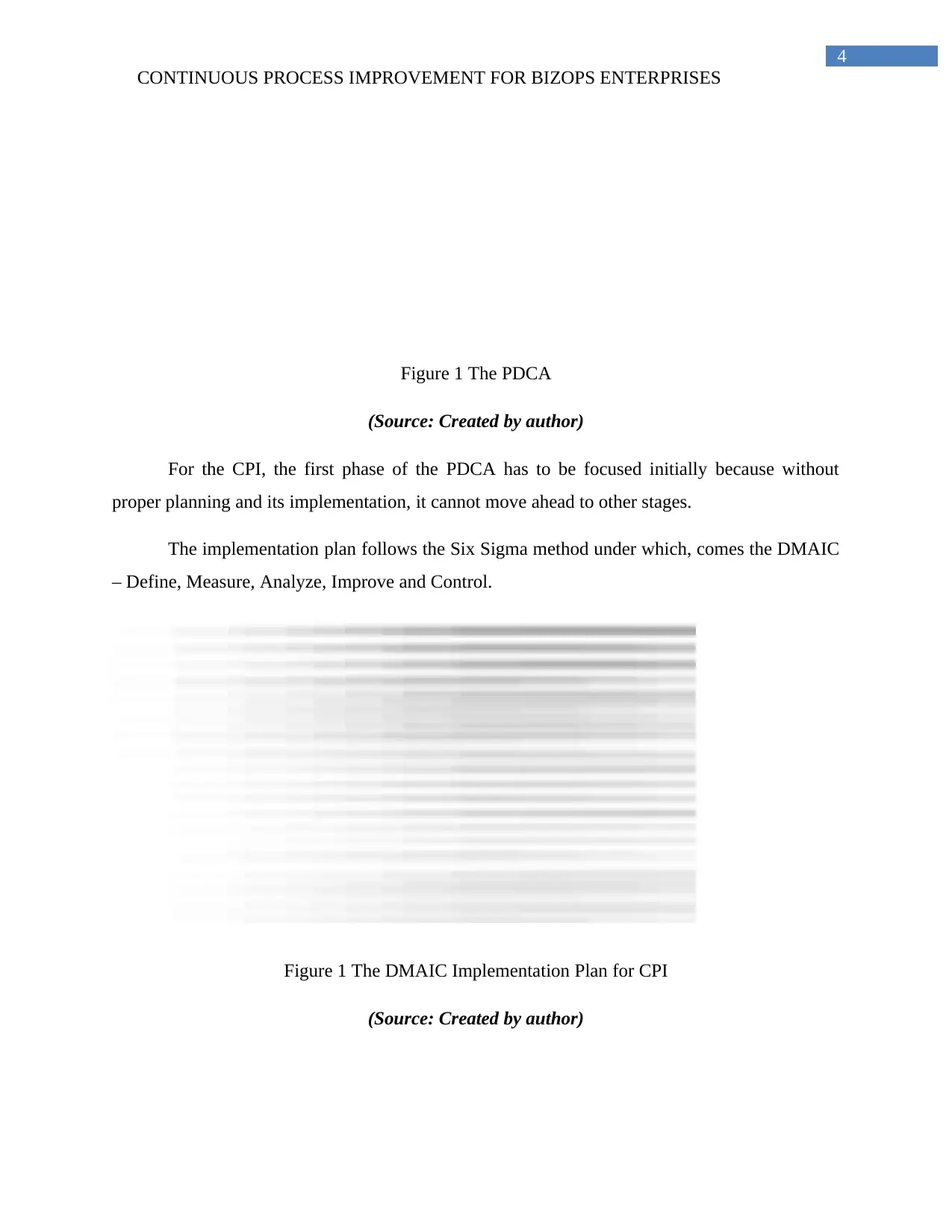
4
CONTINUOUS PROCESS IMPROVEMENT FOR BIZOPS ENTERPRISES
Figure 1 The PDCA
(Source: Created by author)
For the CPI, the first phase of the PDCA has to be focused initially because without
proper planning and its implementation, it cannot move ahead to other stages.
The implementation plan follows the Six Sigma method under which, comes the DMAIC
– Define, Measure, Analyze, Improve and Control.
Figure 1 The DMAIC Implementation Plan for CPI
(Source: Created by author)
PlanDoCheckActMeasure:Documentprocess,collectdata,narrowfocusofprojectAnalyze:Data,identifychiefcauses,removeunwantedstuff
CONTINUOUS PROCESS IMPROVEMENT FOR BIZOPS ENTERPRISES
Figure 1 The PDCA
(Source: Created by author)
For the CPI, the first phase of the PDCA has to be focused initially because without
proper planning and its implementation, it cannot move ahead to other stages.
The implementation plan follows the Six Sigma method under which, comes the DMAIC
– Define, Measure, Analyze, Improve and Control.
Figure 1 The DMAIC Implementation Plan for CPI
(Source: Created by author)
PlanDoCheckActMeasure:Documentprocess,collectdata,narrowfocusofprojectAnalyze:Data,identifychiefcauses,removeunwantedstuff
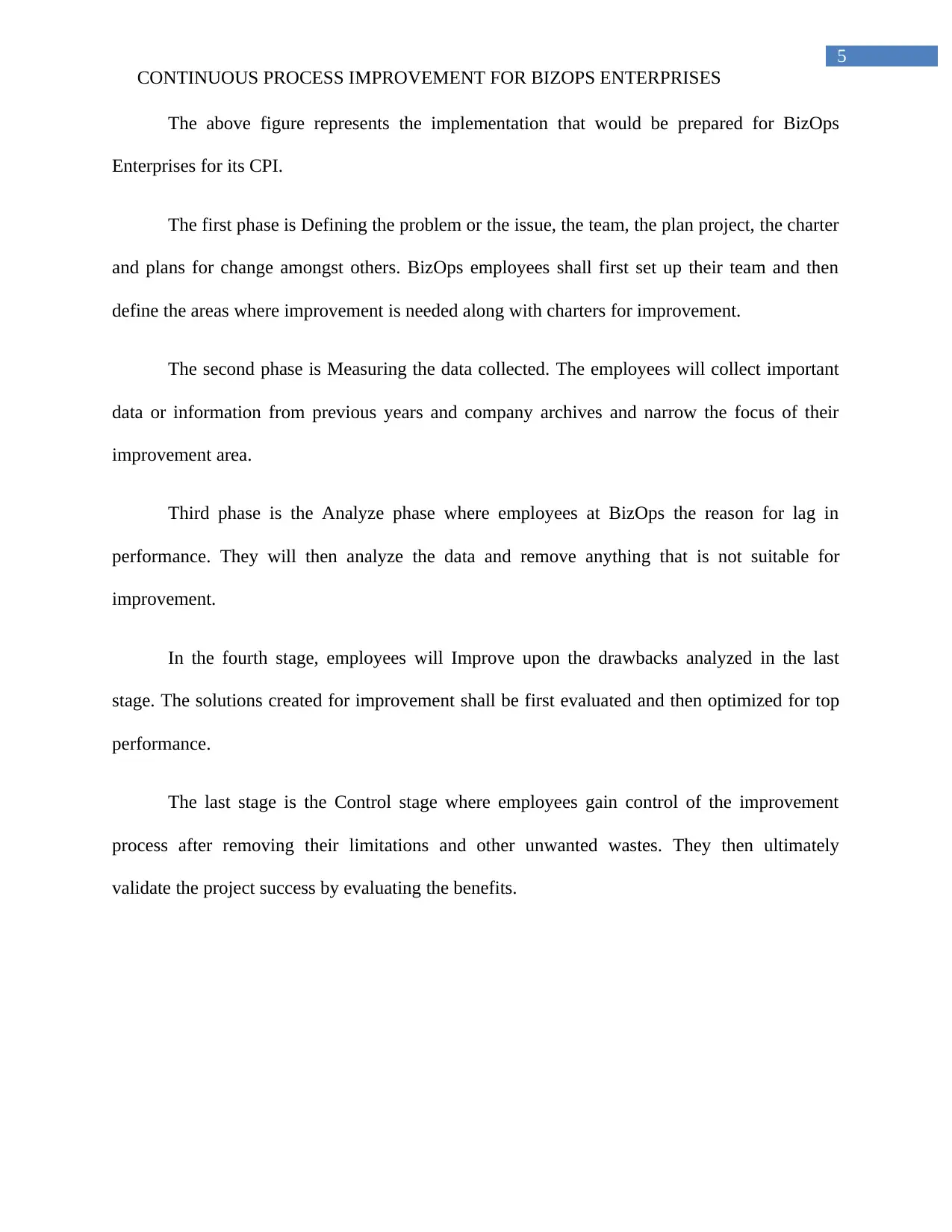
5
CONTINUOUS PROCESS IMPROVEMENT FOR BIZOPS ENTERPRISES
The above figure represents the implementation that would be prepared for BizOps
Enterprises for its CPI.
The first phase is Defining the problem or the issue, the team, the plan project, the charter
and plans for change amongst others. BizOps employees shall first set up their team and then
define the areas where improvement is needed along with charters for improvement.
The second phase is Measuring the data collected. The employees will collect important
data or information from previous years and company archives and narrow the focus of their
improvement area.
Third phase is the Analyze phase where employees at BizOps the reason for lag in
performance. They will then analyze the data and remove anything that is not suitable for
improvement.
In the fourth stage, employees will Improve upon the drawbacks analyzed in the last
stage. The solutions created for improvement shall be first evaluated and then optimized for top
performance.
The last stage is the Control stage where employees gain control of the improvement
process after removing their limitations and other unwanted wastes. They then ultimately
validate the project success by evaluating the benefits.
CONTINUOUS PROCESS IMPROVEMENT FOR BIZOPS ENTERPRISES
The above figure represents the implementation that would be prepared for BizOps
Enterprises for its CPI.
The first phase is Defining the problem or the issue, the team, the plan project, the charter
and plans for change amongst others. BizOps employees shall first set up their team and then
define the areas where improvement is needed along with charters for improvement.
The second phase is Measuring the data collected. The employees will collect important
data or information from previous years and company archives and narrow the focus of their
improvement area.
Third phase is the Analyze phase where employees at BizOps the reason for lag in
performance. They will then analyze the data and remove anything that is not suitable for
improvement.
In the fourth stage, employees will Improve upon the drawbacks analyzed in the last
stage. The solutions created for improvement shall be first evaluated and then optimized for top
performance.
The last stage is the Control stage where employees gain control of the improvement
process after removing their limitations and other unwanted wastes. They then ultimately
validate the project success by evaluating the benefits.
⊘ This is a preview!⊘
Do you want full access?
Subscribe today to unlock all pages.

Trusted by 1+ million students worldwide
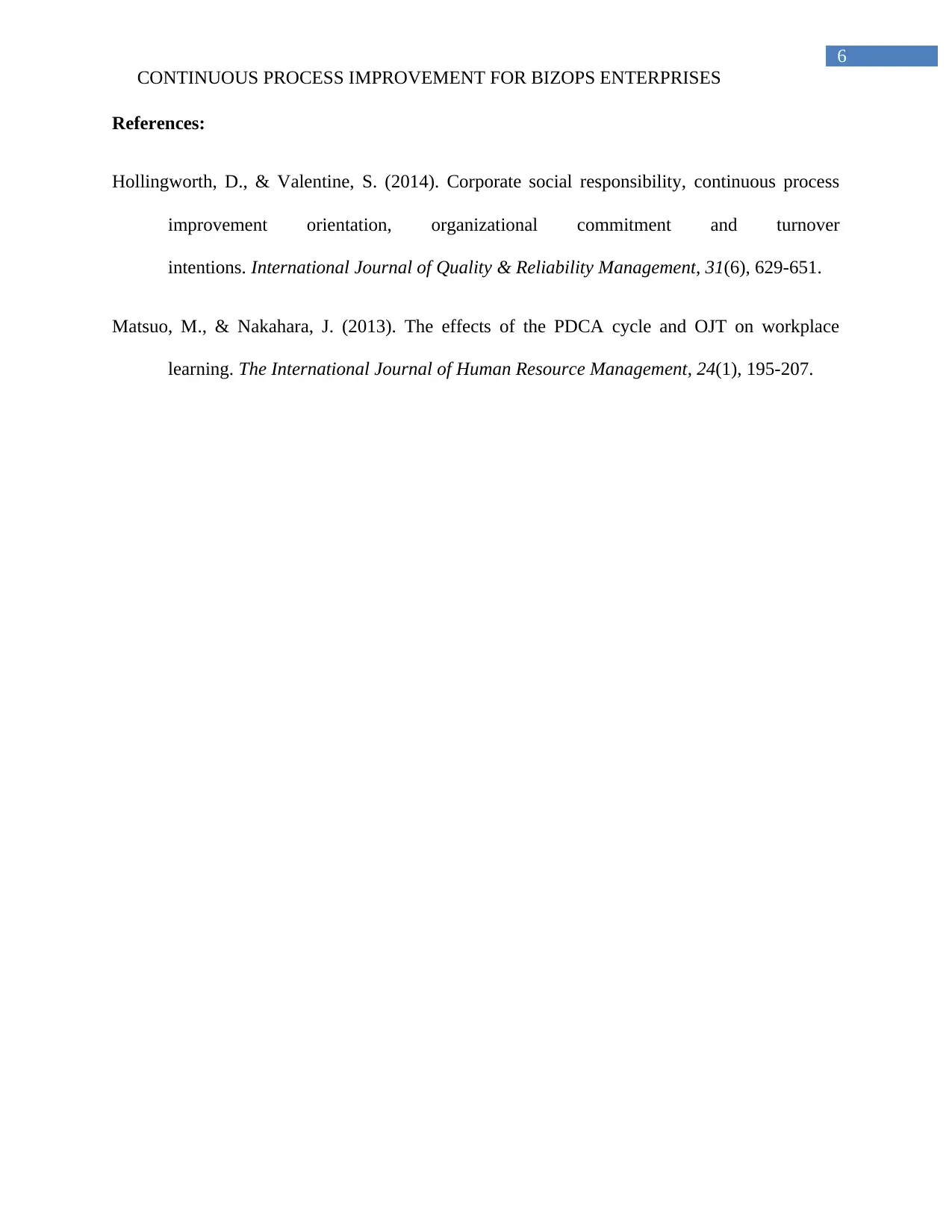
6
CONTINUOUS PROCESS IMPROVEMENT FOR BIZOPS ENTERPRISES
References:
Hollingworth, D., & Valentine, S. (2014). Corporate social responsibility, continuous process
improvement orientation, organizational commitment and turnover
intentions. International Journal of Quality & Reliability Management, 31(6), 629-651.
Matsuo, M., & Nakahara, J. (2013). The effects of the PDCA cycle and OJT on workplace
learning. The International Journal of Human Resource Management, 24(1), 195-207.
CONTINUOUS PROCESS IMPROVEMENT FOR BIZOPS ENTERPRISES
References:
Hollingworth, D., & Valentine, S. (2014). Corporate social responsibility, continuous process
improvement orientation, organizational commitment and turnover
intentions. International Journal of Quality & Reliability Management, 31(6), 629-651.
Matsuo, M., & Nakahara, J. (2013). The effects of the PDCA cycle and OJT on workplace
learning. The International Journal of Human Resource Management, 24(1), 195-207.
1 out of 7
Related Documents
Your All-in-One AI-Powered Toolkit for Academic Success.
+13062052269
info@desklib.com
Available 24*7 on WhatsApp / Email
![[object Object]](/_next/static/media/star-bottom.7253800d.svg)
Unlock your academic potential
Copyright © 2020–2025 A2Z Services. All Rights Reserved. Developed and managed by ZUCOL.





